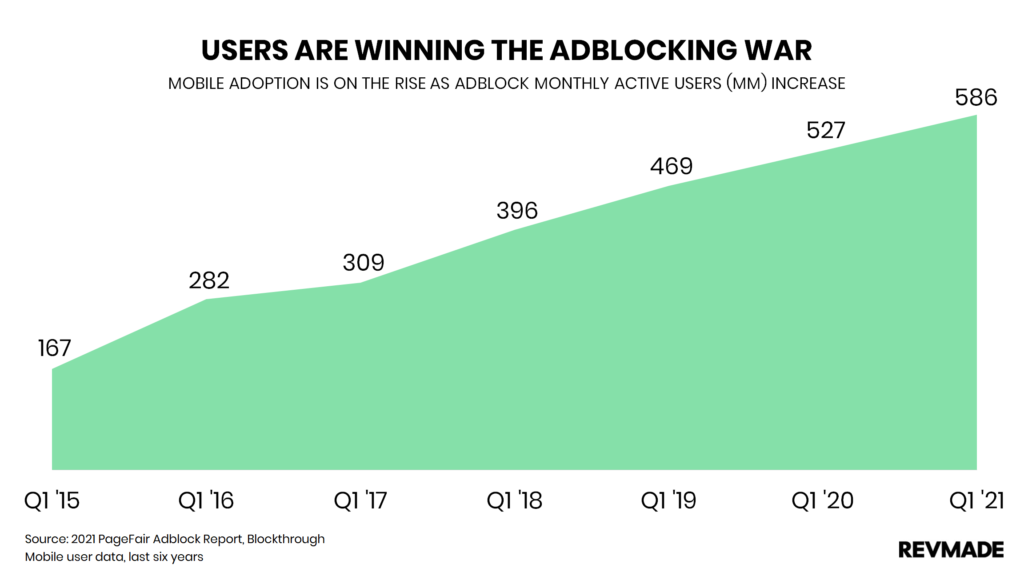This is your brand on adblocking, according to research
As more audiences reject intrusive and irrelevant ads, marketers need to give the people what they wantRevmade regularly scours the internet for new studies that offer important insights for marketers. Then we write them up for you in as few words as possible. (Want to get them emailed to you? Sign up here.)
We recently published a TL;DR on what a trillion ad impressions could teach you about content marketing. But that body of research doesn’t take into account the still-rising share of audiences that use adblockers.
IAB just released a study, the 2022 Digital Ad Ecosystem Report, which describes an industry still grappling with the fact that people frequently reject ads as too intrusive, irrelevant and unwanted. And these negative experiences lead to more than one million new searches for adblocking solutions every month according to our research.
Case in point (in their words): “Today’s modern consumer is fleeing bad ad-supported media experiences. … The consumer migration to ad-light and ad-free content offerings indicates an expectation that advertising delivers a useful and contextually relevant experience, and providing ways to easily and quickly engage (i.e., explore/transact) is demanded.”
Why should I care? The adblocking arms race has been going on for years, but recent developments have begun to favor users over publishers. Browsers such as Brave offer easier ways to customize your ad experiences, blocking most JavaScript by default. And some of the most popular mobile browsers are expanding third-party options for adblocking.
According to a survey by CivicScience, nearly 50 percent of desktop users employ an adblocker, and adblocking on mobile has more than doubled during the last five years.

The more this trend continues, the smaller your audience will be for future ad campaigns, and the more you may have to invest (from your budget) to reach them.
What can I do next? If your paid media campaigns suffer from poor reception and performance, you know it’s time to act. But even if your ads are performing well by traditional metrics, are you sure that it’s the optimal method for outreach and conversion?
In our work at Revmade, we’ve found that well-tuned editorial operations are a powerful tool for audience engagement. It’s a way to tie into what an audience needs, in a format they prefer, with an opportunity to fulfill their desires for usefulness and entertainment. And reach that ever-growing segment of adblocking audiences along the way.
Here are a few tips to help you get started:
- Look for hidden signs of ad fatigue/blocking: Don’t just look at your top-line numbers. Are your campaigns not performing equally well across important audience segments? Are you reaching fewer people than you used to? Or are you seeing declining price or click-through efficacy? Weakness across these portions of your campaigns could be a sign of problems yet to surface.
- Ask your audience what they want: Not all editorial operations are created equal. An expert Q&A franchise has different audience research, staffing and resource needs than a multimedia-heavy field guide. Before you jump in, get a sense of what your audience wants from your organization in the first place.
- Remix your marketing mix: Consider testing organic editorial campaigns to run alongside your paid efforts, and evaluate the most efficient at converting audiences to customers. You might find that each of these channels has a place in your marketing toolkit.
TL;DR: There’s a consumer backlash against bad advertising experiences. Marketers can avoid contributing to this problem through user-friendly editorial campaigns.
Need to remix your marketing mix? Trying to figure out how to boost your organic efforts? Reach out to us for more info.
Subscribe
Get our weekly newsletter for tips on how to drive better content marketing performance.
For a regular stream of ideas, research and links we find helpful. And of course, to say hi!
